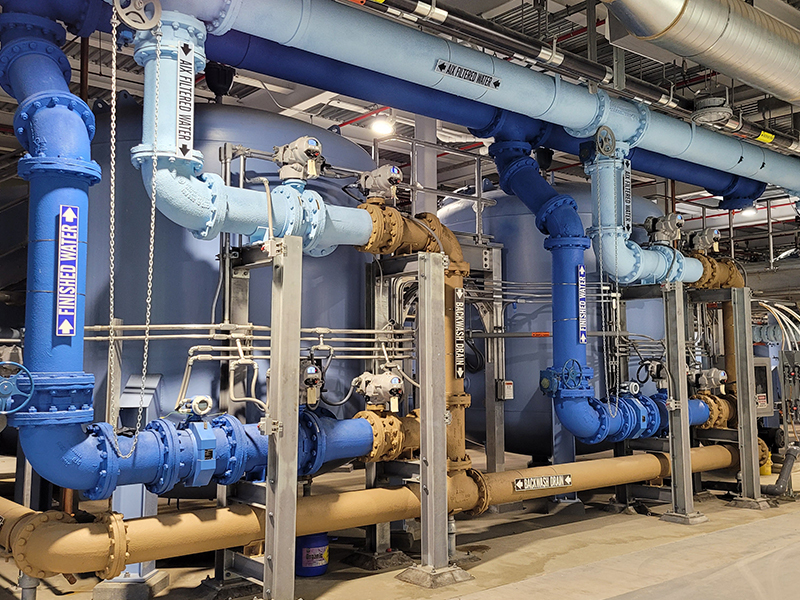Article reposted with permission by the New England Water Works Association.
Abstract
The Infrastructure Investment and Jobs Act (IIJA) of November 6th, 2021, includes a Build America, Buy America (BABA) clause that requires the procurement of domestic products for all federally funded infrastructure projects. This extends beyond iron and steel products to manufactured products and construction materials, which is a change for the water sector. Compliance has been delayed beyond the May 14th deadline as legacy funds are exhausted and waivers exempt some projects already in design; however, service providers must work to understand these requirements and start preparing. Their immediate focus will likely depend on the specific service or product offered.
Introduction
The Infrastructure Investment and Jobs Act, signed into law on November 6th, 2021, will provide much needed funding to the water sector through fiscal year 2026. In order to promote economic development in the United States, the Act includes a domestic procurement requirement, known as Build America, Buy America (BABA), which went into effect on May 14th of this year and extends to all infrastructure projects that receive any federal funding. While there are some similarities to past and existing “Buy American” requirements, BABA criteria for manufactured products and construction materials are new to the water sector, and many service providers are now impacted whether they know it or not.
The BABA requirements apply to any product, component or material incorporated into a federally funded infrastructure project, with few exceptions. Each item procured for an eligible project will fall into one of three categories: 1) iron or steel products, 2) manufactured products, or 3) construction materials. While iron or steel products parallel existing requirements for the use of American Iron and Steel (AIS), BABA’s criteria for manufactured products and construction materials are new to the water sector.
Manufactured products integrate more than one material, component, or other manufactured product to create a unique product. Examples include pumps, motors, blowers, valve actuators, pump skid assemblies, and treatment equipment systems – essentially anything that does not qualify as an iron or steel product or construction material. To meet domestic procurement standards, the product must be manufactured in the United States and the cost of components mined, produced, or manufactured in the United States must be greater than 55 percent of the total cost of components. A manufacturer’s labor is not considered toward their product’s status. This differs from the Buy American requirements of the American Recovery and Reinvestment Act (ARRA) of 2009, where the origin of a manufactured product’s materials and components did not matter as long a “substantial transformation” occurred in the United States.
Construction materials include items other than iron or steel products that consist primarily of non-ferrous metals, plastic and polymer-based products, glass, lumber, or drywall. Cement and cementitious materials, aggregate binding agents or additives, and aggregates such as stone, sand, or gravel, are exempt. While the definition has yet to be finalized, preliminary guidance indicates that at least the final and immediately preceding manufacturing stages must occur in the United States to qualify as a domestic product.
Discussion
Service providers constitute a diverse spectrum of those who provide products or services to the water sector and generally include manufacturers, contractors, consulting engineers, manufacturers’ representatives, and other vendors or distributors. While their utility customers are the ones obtaining federal funding and therefore responsible for adhering to BABA requirements, service providers ultimately will be held accountable to ensure that the products procured or supplied comply. As the different service providers cooperate in this effort, each will have different concerns and areas of focus.
Manufacturers need to know how to comply and, specifically, how the rules apply to their different products in terms of scope. For those who manufacture fully assembled products, like pumps or blowers, the product scope will be obvious. However, many manufacturers, such as those of treatment systems, deliver their product in multiple components for assembly on site by a third-party contractor. This gives some ambiguity but also flexibility to the scope. Manufacturers may get creative and extend or limit their scope of supply based on the balance of domestic components, careful not to diverge from the normal course of business lest they attract scrutiny from compliance inspectors. Further, because a supplier’s labor is inherently included in the final cost of their manufactured product, there could be an incentive for a manufacturer to outsource certain components they would otherwise produce in-house to maximize the value of domestically procured components and offset those that are unavailable, or not easily obtained, domestically. Meeting these requirements may increase costs and lead times, so it is critical that all manufacturers have a similar understanding of the rules to ensure fair competition at bid time.
Documentation standards will be important for submittal and record keeping. While more definition is needed, there is some precedent from AIS that may require a signed certification letter that is product-specific and documents the location of manufacturing. This practice avoids exposing confidential business information related to specific supply chain and bills of materials; however, these details may be helpful or necessary if a product’s origin is ever formally challenged or audited. As such, manufacturers might consider parallel records systems for external submission and internal documentation. The U.S. Environmental Protection Agency (USEPA) has mentioned step certification as a best practice, which would track component certification through the supply chain, but more details would be helpful to understand what might withstand an audit.
Contractors are unique in that they are first in line for any penalties assessed on a project. They will have similar compliance concerns as manufacturers, particularly with construction materials; but they may be extra wary of a supplier’s compliance during bidding phases. Although a basic letter may suffice for documentation purposes, some contractors may demand additional evidence before accepting a supplier’s quotation, at least until a level of comfort and trust is established. Contractors must also balance their pricing with the risk of potential cost overruns or liquidated damages from supply chain difficulties, which could be exacerbated by the new rule especially in the short term.
Manufacturers’ representatives and other vendors or distributors risk gaps in their existing product lines if any current offerings do not meet the domestic production requirements or struggle to comply. If a representative or supplier cannot match a competitor’s package offering, it risks lost work for them as well as their other represented manufacturers. The new rules will likely cause shifts in product lines, and they could impact lead times and pricing by overwhelming the supply chain of compliant products before others can fully adjust.
Manufacturers, suppliers, and contractors will rely on the consulting engineers to determine whether BABA applies and then to define expectations for all stakeholders. Although the law went into effect on May 14th, there was some delay while working through previous funds and now several approved waivers will exempt many projects in the near future. Much of the federal funding will flow through State Revolving Funds (SRFs), and while federal grants fund the SRF program, a project that receives SRF funds is not necessarily receiving federal money. USEPA has stated previously that BABA need only apply to “equivalency” projects, which are those explicitly reported annually to USEPA as recipients of fiscal year grant funding. Other SRF funds originating from state match, or revolving funds from loan repayment and accrued interest, are generally considered state money and could fund projects freely without federal restrictions. However, individual SRF offices may interpret the BABA requirements differently, and it is advised to establish an open dialog with local offices to understand their specific expectations.
Projects that have initiated design planning prior to May 14th could be exempted through general applicability public interest waivers, which were approved by USEPA this summer for SRF and Water Infrastructure Finance and Innovation Act (WIFIA) programs. Another such waiver, recently approved, exempts small projects that will receive less than $250,000 of federal funding. These are among several general applicability waivers that USEPA has approved or initiated to alleviate the initial burden on stakeholders and keep the federal money moving.
While general applicability waivers are driven by the USEPA and apply to all projects, those receiving funding can apply for product-specific waivers on the grounds of public interest, non-availability, or unreasonable cost based on their project’s unique circumstances. The likelihood of a waiver being accepted, and the expected turn-around time, will be critical in an engineer’s determination of what to include in their design. An overly restrictive waiver process could work against innovative or best available technologies and drive solutions based solely on domestic availability.
At the time of this writing, the impacts of BABA have been limited to voluntary actions taken in anticipation of what’s to come. While some projects, despite budget overruns, were rushed to construction to avoid the new requirements, other projects are being postponed, biding time until more guidance and clarity emerges. The USEPA released an implementation memo in early November to supplement the Office of Management and Budget’s (OMB’s) general guidance to federal agencies, which was released in April. In the meantime, manufacturers seem to be at varied levels of preparation, ranging from wishful thinking that things will work themselves out to investigating ways of re-shoring production. The law is intended to increase domestic production, but re-shoring manufacturing may be especially difficult in these current times when supply chain is already stressed. For example, a pump manufacturer explored options to re-shore production in the United States: out of seventeen foundries contacted, twelve gave no response, four gave a partial response, and only one produced a viable option at nearly twice the typical cost.
Potential impacts to supply chain extend beyond just the water sector. BABA impacts all federally funded infrastructure projects, and the water sector must compete with others for domestic materials and products during this funding surge. The total capital spending on water and wastewater infrastructure was approximately $48 billion in 2019, which was reportedly $81 billion below the total need (ASCE, 2021). In the same year, $203 billion was spent on roads (Urban Institute, 2022) and the backlog of additional need was approximately $786 billion in 2021 (ASCE, 2021). While the IIJA will provide around $55 billion for water and wastewater spending over the next five years, over $900 billion is related to transportation and over $100 billion is dedicated to energy and power (GFOA, 2022). Other federal agencies, including the Department of Energy, the Department of Transportation, and the Department of Education, have also enacted waivers as they adjust to the new requirements; however, USEPA seems to lead in steps taken to ease the transition for their funding recipients.
Conclusion
The situation around BABA is evolving as more waivers, guidance, and general understanding emerge while USEPA works with industry stakeholders to better understand their needs and concerns. Although there is no lack of questions or uncertainty, OMB has been clear that these rules are here to stay, and it is only a matter of time before projects start including the BABA requirements. Fortunately, there is enough information available for service providers to educate themselves and start preparing. USEPA has created an email address for direct communication from stakeholders and hosts a dedicated web page with information on the BABA Act, which includes available guidance and information on approved waivers and those pending or open for comment. The American Water Works Association (AWWA) is also following things closely and communicating with USEPA, as are other water associations, such as the Water and Wastewater Equipment Manufacturer’s Association (WWEMA). These are all great resources to help navigate the new requirements and start planning for compliance.
References
ASCE (2021). “Report Card for America’s Infrastructure: Roads.” https://infrastructurereportcard.org/wp-content/uploads/2017/01/Roads-2021.pdf
ASCE (2021). “Report Card for America’s Infrastructure: Wastewater.” https://infrastructurereportcard.org/wp-content/uploads/2020/12/Wastewater-2021.pdf
GFOA (2022). “Infrastructure Investment and Jobs Act (IIJA) Implementation Resources, IIJA Highlights.” https://www.gfoa.org/the-infrastructure-investment-and-jobs-act-iija-was
OMB (2022). “Memorandum for Heads of Executive Departments and Agencies, M-22-11.” https://www.whitehouse.gov/wp-content/uploads/2022/04/M-22-11.pdf
Urban Institute (2022). “Project: State and Local Backgrounders – Highway and Road Expenditures.” https://www.urban.org/policy-centers/cross-center-initiatives/state-and-local-finance-initiative/state-and-local-backgrounders/highway-and-road-expenditures
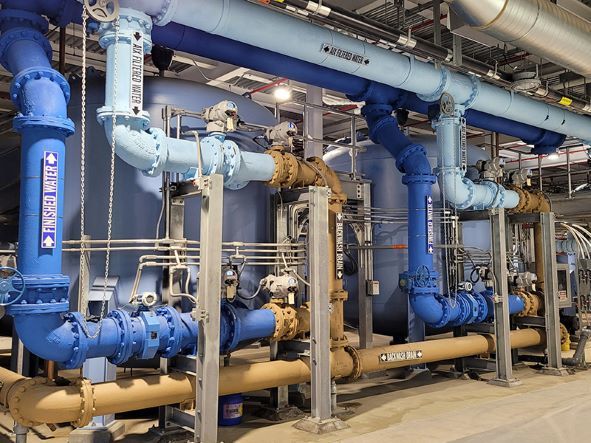 Media filtration system at Topsham, ME (BTWD) is an example of a manufactured product with components shipped separately for installation and assembly on-site by others.
Media filtration system at Topsham, ME (BTWD) is an example of a manufactured product with components shipped separately for installation and assembly on-site by others. 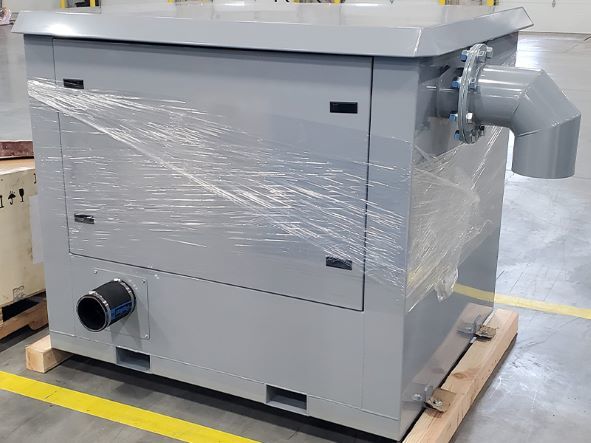 Positive displacement blower package with enclosure is a a manufactured product from a supplier, but it could be considered part of a filtration system’s manufactured product scope if included as an air wash blower.
Positive displacement blower package with enclosure is a a manufactured product from a supplier, but it could be considered part of a filtration system’s manufactured product scope if included as an air wash blower. 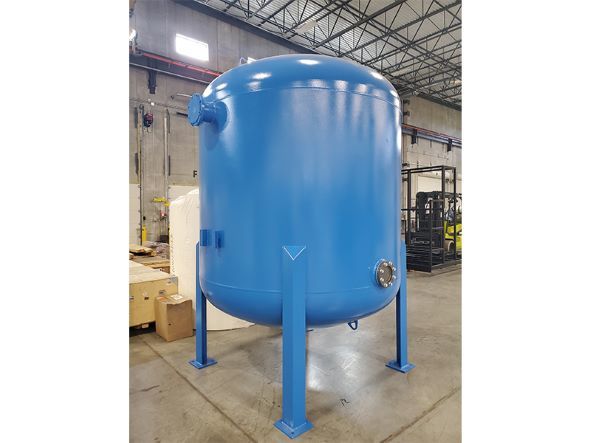 Although a steel vertical pressure vessel is an iron or steel product on its own, AIS does not apply when supplied as part of a media filter system, which would be the manufactured product; however, American steel would count toward the final product’s domestic content.
Although a steel vertical pressure vessel is an iron or steel product on its own, AIS does not apply when supplied as part of a media filter system, which would be the manufactured product; however, American steel would count toward the final product’s domestic content. 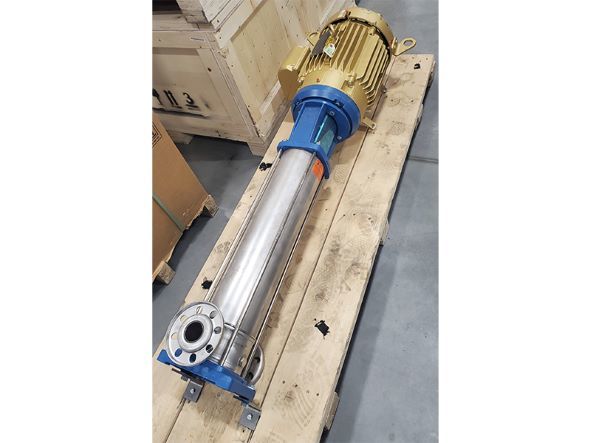 This high pressure pump is a manufactured product from the vendor; however, it is one of many components when included as part of a reverse osmosis (RO) membrane system. Domestic origin may or may not be necessary to the RO system manufacturer depending on the other contents’ origin and cost balance.
This high pressure pump is a manufactured product from the vendor; however, it is one of many components when included as part of a reverse osmosis (RO) membrane system. Domestic origin may or may not be necessary to the RO system manufacturer depending on the other contents’ origin and cost balance. 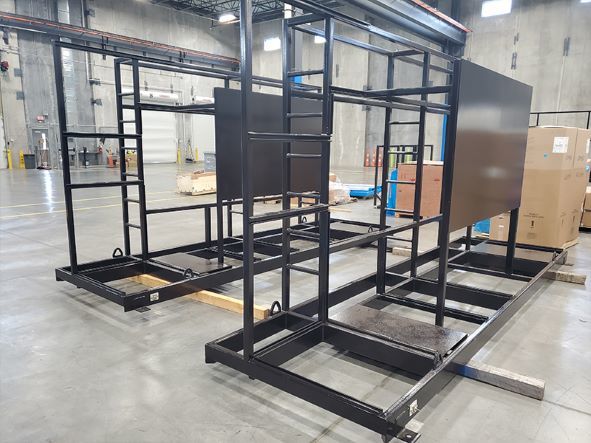 Steel frames for skidded reverse osmosis systems – the use of America steel would help toward ensuring 55% domestic content to comply with BABA.
Steel frames for skidded reverse osmosis systems – the use of America steel would help toward ensuring 55% domestic content to comply with BABA. 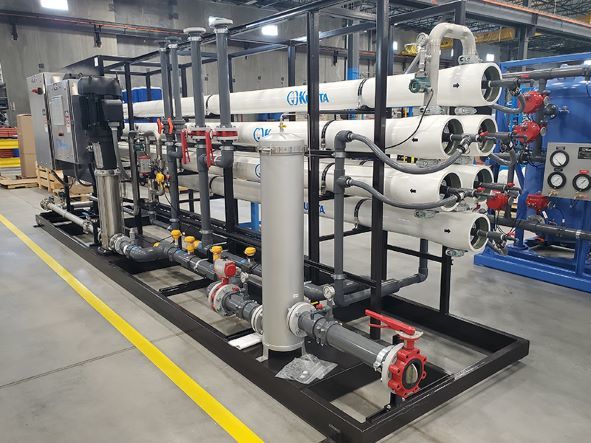 This reverse osmosis membrane skidded system is a manufactured product that incorporates other manufactured products as components. In order to qualify as produced in the United States, the sum of domestic component costs must be 55% or more of the total cost of all components.
This reverse osmosis membrane skidded system is a manufactured product that incorporates other manufactured products as components. In order to qualify as produced in the United States, the sum of domestic component costs must be 55% or more of the total cost of all components. 
